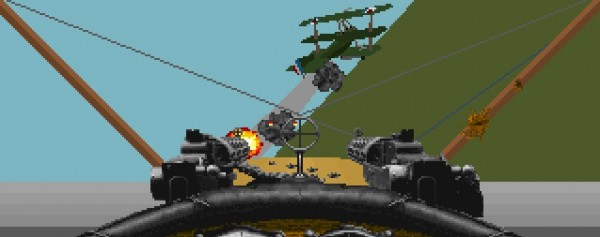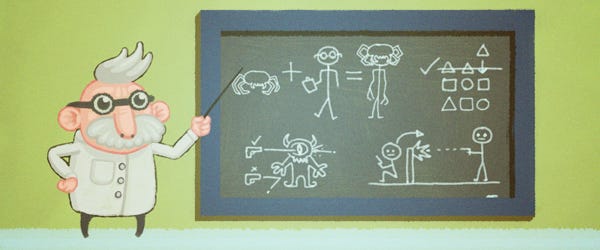The Very Important List Of PC Games, Part 6/5
It becomes clear that the PC gaming faculty at Rock, Paper, University is going to require a consult from Simulated Professor Stone, who occasionally visits us from his laboratory in the woods. We must thank him for this appendix to our round up of the greatest PC games, just as we must thank Intel and their AppUp Developer Program for sponsoring the whole thing.
And now, to the details of war and sims...
Please note: these games are not ranked according to the fidelity of their Panzers.
Close Combat 2: A Bridge Too Far
RELEASE DATE : 1997
IMPORTANCENESS: DSO with bar

Study WW2 aerial images of Normandy, Arnhem or the Ardennes and you won't see a carpet of giant-sized chicken-wire draping the terrain. You won't see evenly-spaced houses equidistant from cardinal and ordinal-aligned roads. Close Combat 2 was the first wargame to acknowledge that battlefields are higgledy-piggledy places, the men scurrying over them, frightened, fallible beings. The result was revelatory. Watching from your metaphysical Storch/Auster as soldiers broke and ran, cowered in ditches, or Nicht Schiessen-ed rather than follow orders, it was impossible to remain aloof. Of course there was unscripted courage too, moments when a hundred variables conspired to make a tiny warrior quit the safety of a crater or shell-blasted house and charge a chattering MG. Would Tommy Tompkins or Hans Hartmann succeed? There was no way of telling. All this exquisite drama was controlled via a gem of UI and given context by an inspired tug-of-war campaign system. The twirly tanks, cramped arenas, and dodgy deployment code were trivial nuisances when viewed against CC2's grounbreaking accomplishments.
Combat Mission: Beyond Overlord
RELEASE DATE: 2000
IMPORTANCENESS: Victoria Cross

I haven't played 'Chance Encounter', one of the scenarios in the CMBO demo, in six or seven years, but if you gave me paper and a pencil I could sketch out the location of every house. hollow, and thicket. When you can play a scenario a hundred times without getting bored of it, you know you're in the presence of greatness. CMBO's greatness was rooted in its impressive realism and unusual (for a wargame) 3D perspective, but the Fun Gas also seeped from less obvious vents. By forcing players to sit on their hands for sixty-second stretches (orders were issued during enforced pauses at the end of a minute's action) Battlefront created one of wargaming's tensest and most resonant control mechanisms. Turns often ended with shells frozen tantalisingly/terrifyingly in mid-flight. Like real commanders, you couldn't intervene at the drop of a hat, you had to trust and cross-fingers. Without resourceful TacAI, the WeGo structure might have been a disaster. Fortunately, Charles Moylan's coding skills were up to snuff. If a plan started unravelling in the middle of a turn the unscripted AI usually had enough nous to abandon or amend it. Men sought cover and fled burning buildings unbidden, outgunned tanks withdrew behind veils of smoke. It didn't matter that every infantry squad was represented with three turnip-headed mannequins, or Sherman suspension wasn't modelled properly, the battle ebb and flow felt uncannily real.
Falcon 4.0
RELEASE DATE: 1998
IMPORTANCENESS: Supersonic

One of the greatest challenges faced by the busy combat flight sim reviewer these days, is finding new, fresh ways of saying "[insertgamenamehere] does a pretty mean dogfight, but fails to provide an interesting context for that dogfight". When I grumble about missing dynamic campaigns, I'm usually comparing the drab mission sequence in [insertgamenamehere] with the amazing living, breathing conflicts served-up by the likes of Falcon 4.0. Microprose's campaign people had the kind of ambition high-flying geese mistake for rivers. When you press the 'Start New Campaign' button you're effectively releasing the brake lever on a giant wargame engine. Tension between North and South Korea suddenly escalates into full-on fisticuffs. The theatre map begins to measle with a rash of unscripted incident icons. Ground forces surge, squadrons scramble, infrastructure nervously eyes skies and horizons. It's tempting to sit back and watch as this magnificent maelstrom intensifies. Tweaking sorties and fiddling with strategy sliders is improbably rewarding, but as one of the most thoroughly simulated aircraft ever is waiting patiently in the wings, it's rarely long before you're clambering into a cockpit and experiencing the mayhem first-hand. Falcon 4.0 is the consummate combat flight sim. It has the realism, the avionic substance, the campaign, the documentation, the scaleability, the de-brief tools ... everything you could want from a serious aerial diversion. The fact that's its still flown and modded by many, is a testament to its unmatched importantitude.
Red Baron
RELEASE DATE: 1990
IMPORTANCENESS: Fokking important

At some point during the last ten years Flight Simulation forgot how to make small talk, laugh at other people's jokes, and use soap. When I see it try to mingle these days, I find myself wincing and wanting to rush over with a copy of Red Baron. RB hit the sweetspot between Sim and Game dead-on. The flight models are plausible without being cruel. The hostile AI is just hostile enough to encourage regular six-checking and occasional hasty retreats. The true glory, however, is in the story, or rather the lack of one. Dynamix let us write our own Flying Fury on the fly by providing a campaign built around randomly generated sorties and engaging inter-mission activities. In the lulls between sky skirmishes, medals are dished-out, promotions gained, transfers requested, newspapers read, and (once you've made Captain) planes customised. This is a game that understands that meeting the Red Baron amongst the clouds is doubly exciting when that meeting is the result of a personal challenge dropped onto your airfield by Richthofen himself.
Airborne Assault: Red Devils Over Arnhem
RELEASE DATE: 2002
IMPORTANCENESS: Unmentioned in dispatches

You won't find AARDOA in other game lists because a) other game lists smell of fox wee, and b) sometimes making 95% of a genre feel moribund at a stroke, doesn't earn you respect. Before this little marvel skidded to a halt on the wargaming LZ, most people's idea of an operational wargame involved acres of hexagons and lots of laborious counter pushing. Australian outfit Panther Games took all these boardgame conventions and stuffed them where the sun don't shine (Scarborough). They were more interested in simulating war than simulating existing simulations of war. Their counters moved freely on hexless maps, and represented tiny interdependent armylets. Yes you could drag-select the 1st, 2nd, 3rd, 4th and 5th Coys of 8SS Recon Battalion, and send all them swanning towards Ooosterbeek, but doing so would make Panther chief Dave O'Connor cry. The cleverer, slicker option was to click on the HQ of 8SS Recon Battalion, give it a nuanced order, then watch as its tiny invisible CO interpreted, planned and executed the instruction. Every link of the command chain was modelled meaning spectacularly lazy wargamers could just select their biggest cheese, issue an order and sit back and watch as the order rippled downwards and outwards. The enemy AI was as cunning and intertwined as the friendly stuff. Later instalments of the series beefed up areas such as supply modelling and pathfinding while retaining at their cores the magic mix of ergonomy and truth that made Red Devils so devilishly good.
Battle of Britain II: Wings of Victory
RELEASE DATE: 2005
IMPORTANCENESS: Air Chief Marshal Hugh Dowding

A significant portion of the people currently paid to produce flying games seem to think the fire button is the most important part of a joystick. Pack enough soft targets into a small enough chunk of sky, and, bingo, joy is forthcoming. These people are misguided and dangerous. They need Battle of Britain II in their lives. Based on Rowan Software's 2001 swansong, BoB2 is a sim that dishes out glory with a teaspoon, and fear, excitement, and failure with a ladle. If you return from a sortie with one Heinkel, Stuka, or Bf 109 under your belt you feel genuinely elated and, probably, utterly exhausted. Thanks to peerless AI code (massaged post-release by a band of official modders) every dogfight is different. Thanks to a campaign approach similar to Falcon 4.0's, every victory makes Goering that little bit angrier. If the purpose of a combat flight sim is to simulate combat conditions and pilot emotions as well as machinery and flight behaviours, then BoB2 is a strong candidate for genre zenith. Breathless, breathtaking, gritty and gruelling... it will be interesting to see how Cliffs of Dover measures up.
Flight Simulator X
RELEASE DATE: 2006
IMPORTANCENESS: Jumbo

The Flight Simulator series is endearingly modest. That terse moniker doesn't hint at the riches that reside on the groaning hard-drive of the average MSFS user. 510,072,000 square km of seamless global scenery? CHECK. Accurate recreations of hundreds of different type of machines-that-fly? CHECK. Stress relief more potent than any benzodiazepine? CHECK. In a medium where everyone and their dog is trying to tell us a story, amuse us, scare us, or bury us in steaming viscera, it's strangely liberating to spend time with a game that simply wants us to leave the ground. The FS user knows why swallows smile, greenfinches grin, and larks lark about. He understands the beatific calm the airliner passenger feels gazing out across frothy cloud tops. Assuming he hasn't got framerate issues, that is. Predictably, FSX is the neediest of the FS line. It out-importants its predecessors primarily by out-prettying them and outliving them. However the mysterious Microsoft Flight turns out, the tenth FS looks set to endure. The flocks of plane makers, terra formers, and peace seekers will see to that. The recent wave of gun-free Euro sims can steal Microsoft Flight Simulator's font, but they'll never match its majesty.
Please note that this post is but one fragment of a larger list, which in total covers over 100 of what RPS feels is the PC’s most important games (but not all of them). You can find the other parts to date here.
This feature has been kindly sponsored by:

